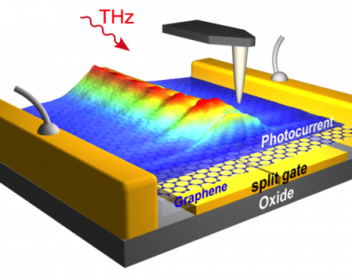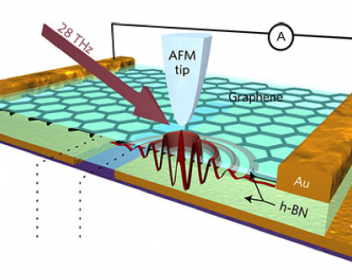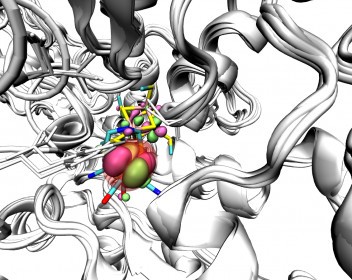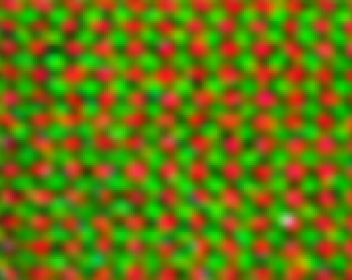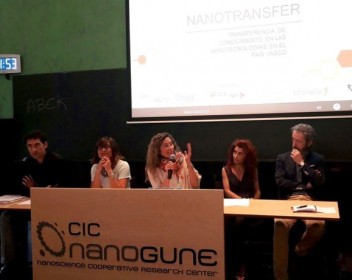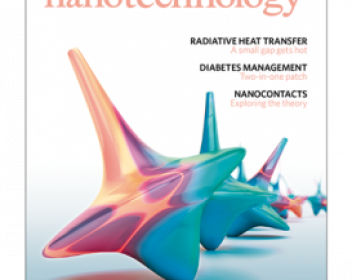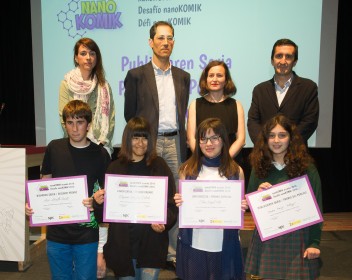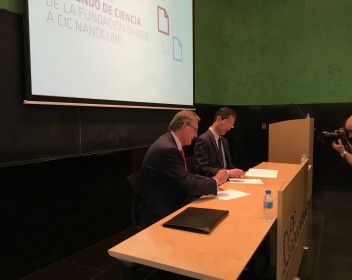Prentsa-bulegoa
Albisteak
DIPCko, MFZko eta nanoGUNEko bi ikertzaile, Journal of Physicsen historiako hamabi artikulu garrantzitsuenetako baten egilekideak
Materialen Fisika Zentroko (CSIC-UPV/EHU) Daniel Sánchez Portal eta Cambridgeko Unibertsitateko irakasle eta CIC nanoGUNEko Ikerbasque ikertzaile Emilio Artacho, biak Donostia International Physics Center-eko (DIPC) kideak, Journal of Physics sailaren 50 urteko historiako hamabi artikulu garrantzitsuenetako baten egilekideak dira, argitalpenaren editoreen arabera. 2002an argitaratu zuten aukeratutako lana; simulazio atomikoko kode berri eta eraginkor bat aurkezten zuen, bere siglengatik SIESTA deritzona, eta gaur egun luze eta zabal erabiltzen da.
Grafenozko plasmoien detekzio elektrikoa terahertzen maiztasunetan
Fotokorronteak nanoeskalan behatzeko teknika berri bat garatu du ikerketzaile-talde batek, eta grafenozko fotodetektagailu batean ikaragarri konprimatuta dauden uhin elektromagnetikoak (plasmoiak) terahertzen maiztasunetan behatzeko erabili dute. Plasmoiek uhin-luzera izugarri motza izateak, batetik, eta eremu oso kontzentratuak izateak, bestetik, bide berriak ireki dituzte terahertzen espektro-tartean gailu optoelektroniko miniaturizatuak garatzeko (Nature Nanotechnology DOI: 10.1038/NNANO.2016.185)
Graphene does double duty for plasmons
A study by ICFO, CIC nanoGUNE, Columbia University and the National Institute for Materials Science in Japan published in Nature Materials demonstrates how graphene can be employed simultaneously as both a plasmonic medium and detector.
Aurrerapauso berriak energia garbiaren ekoizpenean, zenbait entzimari esker
Oxigenoak hidrogenasa entzimak inhibitzen ditu; entzima horiek hidrogenoa sortzeko eta banatzeko gai dira. Degradazio hori halabeharrezkoa da energia garbia ekoizteko entzima horiek izan ditzaketen aplikazio bioteknologikoetan. Horrenbestez, oinarrizkoa da prozesu horren mekanismoa ezagutzea. Nazioarteko ikerketa-talde batek, UCL (Erresuma Batua), CNRS (Frantzia) eta nanoGUNE/Ikerbasque zentroetako ikertzaileak buru direla, teoria eta esperimentuak uztartu ditu oxigenoaren erredukzioaren erreakzio kimikoaren etapa bakoitza karakterizatzeko, betiere entzimetan oinarrituta. Lan horren emaitzak Nature Chemistry aldizkarian argitaratu dituzte.
Coexistence of superconductivity and charge density waves observed
Scientists at Max Planck Institute for Solid State Research, BESSY II Synchrotron and nanoGUNE have discovered that an artificial structure composed of alternating layers of ferromagnetic and superconducting materials induce Charge Density Waves deeply into the superconducting regions, indicating new ways to manipulate superconductivity. The results have been published in Nature Materials.
Hainbat neurri enpresen nanoteknologiako eskaria handitzeko
Proiektuari Nanofransfer nanozientzien aldeko apustua euskal ekonomiaren ekoizpena eraldatzeko prozesuan funtsezko estrategiatzat hartzen du Orkestra-Lehiakortasunerako Euskal Institutuko, Tecnaliako, CIC Nanoguneko, NanoBasque-SPRIko eta Deustuko eta Euskal Herriko Unibertsitateetako adituek proiektu bat egin dute elkarrekin, Euskal Autonomia Erkidegoan nanozientzien, mikroteknologien eta nanoteknologien garapena eta ezarpena aztertzeko. Proiektuari Nanofransfer izena eman zaio eta nanozientzien aldeko apustua euskal ekonomiaren ekoizpena eraldatzeko prozesuan funtsezko estrategiatzat hartzen du. Halaber, nanoteknologiak fabrikazio prozesuetan eta merkatuari eskaintzen zaizkion produktuetan txertatzea bizkortu beharra azpimarratzen du.
Reconfigurable magnetic nanopatterns
A team of international scientists led by researchers of the CUNY Advanced Science Research Center (ASRC) and the Politecnico of Milan, and involving researchers from nanoGUNE, has demonstrated a novel approach for designing fully reconfigurable magnetic nanopatterns whose properties and functionality can be programmed and reprogrammed on-demand. The research has been featured on the June 2016 issue of Nature Nanotechnology.
Bihotzekoak eta immigranteak, nanoKOMIK sarietako irabazle
Gaur arratsaldean izan da nanoKOMIK erronkaren sari-banaketa, DSS2016ko egoitzan. Lehen saria Crisis cardíaca komikiarentzat izan da, nanoteknologia biomedikuntzan erabiltzearen inguruko gaia ukitzen duen lan bat. Egilea: Dayanne Huayhua (Aranjuez). Bigarren saria Asier Murillok irabazi du (Iruñea), Milan man izeneko komikiarengatik. Murillok Mediterraneoan gertatzen ari den immigrazioari buruzko gaurkotasun-istorio bat kontatzen du. Horiez gainera, ikusleen saria eta sari berezi bat ere eman dira.
Ikerketa eta merkaturako transferentzia bultzatzeko hitzarmen bat
José María Arias Mosquera Fundación Barriéko presidenteak eta Jose Maria Pitarke CIC nanoGUNEko zuzendari nagusiak hitzarmen bat sinatu dute, gaur, Donostian, Fundación Barriék bere Zientzia Funtsaren bidez emaitza zientifiko-teknologikoak merkatura transferitzeko garatu duen metodologia ezartzeko nanoGUNEn.
Gipuzkoako Zientzia eta Teknologia Parkeak eta CIC nanoGUNEk nanoteknologia sustatzeko hitzarmena sinatu dute
Euskal Parkeetako presidente José Miguel Corresek eta nanoGUNE IKZko zuzendari José María Pikarte de la Torrek izenpetu duten lankidetza-hitzarmenaren bidez, erakunde biek konpromisoa hartu dute nanoteknologia sustatzearen alde lan egiteko.
Agenda
| Al | As | Az | Og | Or | Lr | Ig |
|---|---|---|---|---|---|---|
|
1
|
2
|
3
|
4
|
5
|
6
|
7
|
|
|
|
|
|
|
|
|
|
8
|
10
|
11
|
12
|
13
|
14
|
|
|
|
|
|
|
|
|
|
|
17
|
18
|
20
|
21
|
|||
|
|
|
|
|
|||
|
22
|
23
|
24
|
25
|
26
|
27
|
28
|
|
|
|
|
|
|
|
|
|
29
|
30
|
31
|
1
|
2
|
3
|
4
|
|
|
|
|
|
|
|
|
Ekitaldiak
- 2026/02/04 - 2026/02/06
nanoGUNE Winter School 2026
nanoTEKA
Aurkitu argazkiak, irudi esperimentalak, bideoak, audioak eta nanoGUNErenirudi korporatiboa.

